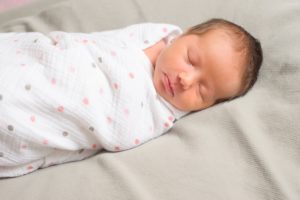HOW TO KEEP YOUR SLEEPING BABY SAFE
The first few months at home with a newborn can be especially stressful, especially when it comes to sleep. Here are Dr. Jessica Long‘s tips on how to keep your sleeping baby safe.

I am expecting my third daughter in the Spring and the thought of going back to sleepless nights is sort of terrifying. Nothing plagues parents of small children like sleep – or lack thereof – and you would be hard pressed to find a new parent who can get through a conversation without mentioning their baby’s horrible sleep patterns. While I worry about the late night awakenings, I at least do not have to stress about how I put my baby down at night to keep her as safe as possible. With these simple tips you don’t have to either.
Back in the day when we were all babies, most parents placed their little ones on their bellies to sleep. In the 1990s, as studies showed that belly sleeping increased baby’s risks of Sudden Infant Death Syndrome (SIDS), the Back To Sleep Campaign championed a safer sleep position. Since then, the number of SIDS deaths has dropped precipitously – by more than 40% – and we now know of other simple steps you can take to keep your child safe at night.
Babies should sleep in their own space – not in the bed with their parents but ideally in the same room. The American Academy of Pediatrics (AAP) recommends keeping your child in a crib or bassinet in your room for ideally the first year but definitely the first six months. Your little one should have a flat, firm mattress with no pillows, blankets, bumper pads or stuffed animals. Instead of loose blankets that can be wiggled around to accidentally cover a child’s face, you can place your baby in a sleep sack. While they are adorable, baby crib bumpers should be avoided due to cases of babies smothering in them. Yes, a bare crib looks boring but boring is safe when it comes to a baby who cannot move to protect her breathing.
There are many products out there that promise to provide further protection against SIDS. Everything from heart monitors that link to your smart phone to bassinets with build in fans is available for purchase. The AAP does not endorse any of these devices as they have not been shown to actually reduce the risk of SIDS. Unless your child was sent home from the hospital with additional medical monitoring of breathing or heart rate, save your money and your sanity and skip these unnecessary gimmicks.
While following the ABCs (Alone, on her Back, in a bare Crib) of baby sleep positions may not get you any additional hours of sleep, it will at least let you rest easy that your child is as safe as possible while you both catch some hard earned zzz’s. Happy dreaming!


